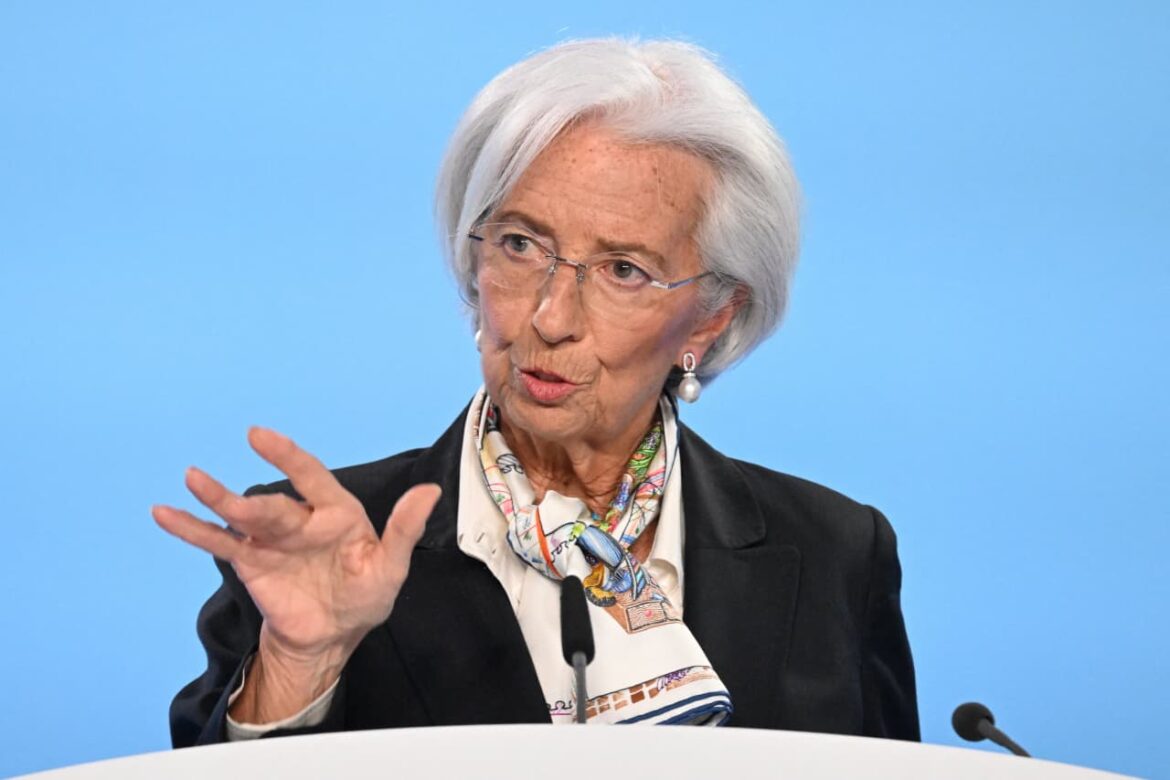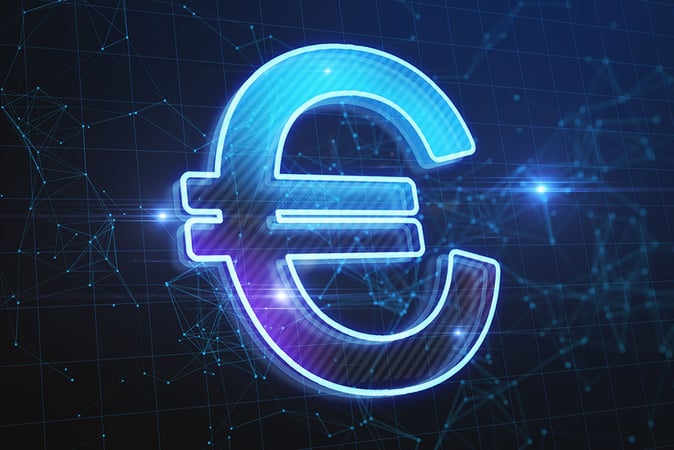
The European Central Bank is expected on Thursday to leave interest rates at record highs but to imply that a cut in borrowing costs is likely by the summer
Source link
euro

In a recent meeting with the European Parliament’s Committee on Economic and Monetary Affairs, Piero Cipollone, a member of the ECB Executive Board, discussed the forthcoming digital euro, specifically its privacy features, infrastructure procurement, and operational standards.
Cipollone’s presentation emphasized the ECB’s proactive approach to collaborating with EU-based entities for the digital currency’s infrastructure. He added that all these entities are registered within the EU and controlled by an EU national.
Privacy concerns
Privacy considerations were a key focus of Cipollone’s remarks. He assured the Parliament that the digital euro would feature superior privacy protections compared to existing commercial payment solutions and include anonymous offline payment transactions.
The ECB executive detailed the planned privacy features of the digital euro, stating that it would collect only a minimal set of pseudonymized data necessary for operations such as settlement. This approach is intended to enhance online payment privacy, addressing public concerns over data protection in digital transactions.
For online transactions, the ECB would access only a necessary, pseudonymized data set for operational purposes like settlement, promising users greater data control than current private payment systems offer.
Moreover, according to Cipollone, the digital euro is designed with top-tier cybersecurity measures to safeguard user data and transactions.
Cipollone said the digital euro has been designed to mirror the accessibility and reliability of cash, thereby reducing reliance on global payment processors and ensuring uniform service across the eurozone. He added:
“Cash and a digital euro have the same objective: ensuring that everyone, regardless of their income, can pay in any situation of daily life. This is a fundamental right. And it should be protected in the same way in all parts of the euro area.”
He likened the digital euro’s infrastructure to public railways, suggesting it would be state-owned yet accessible to various private operators.
Implementation and stability
Cipollone also touched on the importance of a digital euro rulebook to ensure consistent implementation across the eurozone, aiming to reduce dependency on international payment processors by providing a uniform set of rules, standards, and procedures.
Addressing financial stability, the ECB executive outlined measures to prevent the digital euro from competing with traditional savings accounts, including interest-free holdings and restrictions on the digital euro’s accumulation by corporations and financial institutions.
He also mentioned plans to facilitate seamless transactions by linking CBDC wallets with bank accounts, circumventing the need for wallet pre-funding.
The dialogue between the ECB and the European Parliament is part of the preparatory phase for the digital euro, with the ECB providing technical input to co-legislators. The ECB’s efforts aim to prepare for a potential digital euro launch within a framework that prioritizes privacy, operational readiness, and financial stability.
To uphold the token’s value, stablecoin issuers often reserve cash or liquid assets. Amid rising interest rates, DWS is poised to manage the reserves for the new stablecoin.
Deutsche Bank’s DWS Group, along with Dutch market maker Flow Traders Ltd. and crypto fund manager Galaxy Digital Holdings Ltd, is set to establish a new entity named AllUnity. The primary objective of AllUnity is also to issue a euro-denominated stablecoin, aiming to foster wider acceptance of tokenized assets in mainstream finance.
The company, headquartered in Frankfurt and led by Alexander Höptner, former BitMex CEO, plans to apply for an e-money license with Germany’s financial watchdog, BaFin, with the ambition to launch the stablecoin within the next 18 months.
Drawing on their collective expertise in both traditional and crypto markets, the consortium aims to create a successful stablecoin tailored for institutions, corporates, and private users. DWS, majority-owned by Deutsche Bank, oversees assets totaling €860 billion ($927 billion), while Flow Traders, active in the crypto space since 2017, traded assets worth €2.8 trillion ($3 trillion) in the first half of the year.
For the Euro stablecoin launch, the DWS Group has partnered with Galaxy Digital. Galaxy Digital, led by renowned investor Michael Novogratz, offers a range of services, including crypto trading, asset management, and mining. Speaking on the development, Höptner further said:
“You need to have the stability, the trust, the connection and market power to make stablecoins really viable and usable. This partnership is pretty unique because it combines the trustworthiness of a big asset manager, that of a highly successful market maker and of a leading innovator in the crypto sector.”
Growing Focus on Euro-Backed Stablecoin
In a strategic move, Deutsche Bank’s DWS Group, Flow Traders, and Galaxy Digital plan to create AllUnity, a Frankfurt-based company, to issue a euro-denominated stablecoin. The collaboration reflects a growing trend among major institutions entering the stablecoin market, catering to crypto’s widely traded tokens often pegged one-to-one with traditional assets like the dollar.
To uphold the stability of the token, issuers of stablecoins usually reserve a certain amount in cash or liquid assets, like US government securities. With the current upward trend in interest rates, this model has proven to be a profitable venture for stablecoin issuers. The intention is for DWS to oversee the reserves of the planned stablecoin, as stated by Höptner.
Stablecoins, known for their low volatility, appeal to traders and businesses for various use cases, including swift cross-border transactions and facilitating digital payments. While the stablecoin market has reached $130 billion, the dominance of dollar-backed tokens, notably Tether’s USDT, is evident. Besides, Euro stablecoins have seen lower demand, with monthly trading volumes averaging $90 million compared to $600 billion for USD stablecoins.
Societe Generale’s crypto asset subsidiary recently introduced its euro-denominated stablecoin, EUR CoinVertible, on the Bitstamp crypto exchange. The European Union’s new cryptoasset regime provides a regulatory framework, potentially driving greater adoption of euro-denominated tokens. AllUnity plans to launch in Q1 2024, contingent on regulatory approvals and obtaining a full e-money license.
next
Blockchain News, Cryptocurrency News, News
You have successfully joined our subscriber list.
Crypto exchange Binance is reimbursing users and delisting the Anchored Coins Euro (AEUR) stablecoin after the token surged more than 200% in value after listing.
According to a Dec. 6 announcement, Binance will compensate users who purchased AEUR at an inflated valuation and failed to sell it after trading was halted earlier in the day. Affected users will receive a portion of the premium amount above the peg of 1 AEUR = 1.08 Tether (USDT) as a refund. The exchange wrote:
“After AEUR went online, it attracted the attention of community users. However, some users did not realize that AEUR was a stable currency when they purchased it. Demand surged in the short term, resulting in price deviations.”
The large price volatility also affected the pricing of various AEUR trading pairs, including Bitcoin (BTC), Ether (ETH) and the euro, which also falls within the scope of the exchange’s compensation plan. “To avoid potential losses for other investors, the resumption time of the above AEUR spot trading pairs will be notified separately,” Binance said. The coin is currently suspended for trading on the exchange.
AEUR is issued by Anchored Coins, a fintech firm based in Zug, Switzerland. It is part of the country’s self-regulatory organization, Verein zur Qualitätssicherung von Finanzdienstleistungen (VQF), which is endorsed by the Swiss Financial Market Supervisory Authority (FINMA), requiring the firm to comply with Anti-Money Laundering obligations.
Anchored Coins claims that each AEUR is “backed 1:1 with the reserves held exclusively with Swiss FINMA-licensed banks.” The firm’s stablecoins are currently minted on Ethereum and BNB Smart Chain.

Related: Circle launches native euro stablecoin on Stellar
Unlike what JPMorgan offers with its JPM Coin, the EUR ConVertible will be available for trading, thus opening up immediate access for a wide range of investors.
Societe Generale, the third-largest bank in France is set to launch its EUR CoinVertible stablecoin on the crypto exchange Bitstamp. The move represents a pioneering effort by the Paris-based bank as it will be the first bank to offer a stablecoin on a cryptocurrency exchange.
For what it’s worth, the bank’s groundbreaking action will cause a major shift in the way traditional financial institutions view stablecoins and the crypto space in general. That is not to mention the widespread attention it will also bring to digital tokens that track hard currency values.
Before now, traditional financial institutions have threaded with caution when it comes to crypto. However, according to the Financial Times, which first broke the news, crypto market enthusiasts now have a reason to believe that there is a growing popularity of stablecoins on a global scale.
Societe Generale to List EUR CoinVertible, Hammers on the Need for A Euro-Denominated Stablecoin
Societe Generale is set to do things a little bit differently with its stablecoin, EUR CoinVertible. That is because this is not the first attempt by a traditional financial institution to launch a stablecoin.
However, as earlier mentioned, Societe Generale intends for its stablecoin to be listed on Bitstamp exchange. This means that unlike what JPMorgan offers with its JPM Coin, the EUR ConVertible will be available for trading, thus opening up immediate access for a wide range of investors.
About the decision to introduce the new stablecoin, Jean-Marc Stenger, the CEO of Societe Generale, notes that the crypto space currently has just a few stablecoins. He then added that about 90% of even the few ones available are predominantly backed by US dollars. So, it is only necessary that a stablecoin denominated in euros comes to play a role, Stenger noted.
Controversy, Regulatory Compliance, What Next?
The efforts of Societe Generale, particularly with its stablecoin, have not come without some negative reactions. Some observers have noted something in the smart contract code for Euro CoinVertible. They claim that the smart contract requires that a transaction be authorized by a centralized registrar before being completed. This, according to keen observers, is a way for the bank to control the stablecoin.
Also, there is concern about whether or not Societe Generale has considered the upcoming MiCA regulation. However, the bank also assures that the EUR Coinvertible is designed to align perfectly with the impending rules.
Without a doubt, the landscape of tokenized assets is evolving and beginning to take up a more defined shape. And Societe Generale may just be set to play a huge role in ensuring that happens.
next
Blockchain News, Cryptocurrency News, News
You have successfully joined our subscriber list.
If successful, the project will further move to the next stage, closer to the issuance. The full rollout will be possible only after completing the European Union’s legislative process by the Governing Council.
The Governing Council of the European Central Bank (ECB) is moving to the next phase of the digital euro project – the preparation phase. For the next two years starting from November 1, the guideline on the use of the digital euro rulebook will be established, and providers in charge of the platform and infrastructure will be chosen. The preparation phase will also include testing and experimentation to develop a digital euro that will meet both the Eurosystem’s requirements and user needs in terms of user experience, privacy, financial inclusion and environmental footprint.
Our Governing Council has decided to move to the next phase of the digital euro project.
In November 2023 we will start laying the foundation for the possible issuance of a digital euro. A decision on issuing a digital euro will come at a later stage. pic.twitter.com/Nn0Z8RggVn
— European Central Bank (@ecb) October 18, 2023
If successful, the project will further move to the next stage, closer to the issuance. The full rollout will be possible only after completing the European Union’s legislative process by the Governing Council.
ECB President Christine Lagarde commented:
“We need to prepare our currency for the future. We envisage a digital euro as a digital form of cash that can be used for all digital payments, free of charge, and that meets the highest privacy standards. It would coexist alongside physical cash, which will always be available, leaving no one behind.”
The ECB has highlighted that when it comes to central bank digital currency (CBDC) development, the priority in the digital euro development is data protection. The goal is to achieve a ‘cash-like level of privacy for offline payments’.
Fabio Panetta, ECB Executive Board member and Chair of the High-Level Task Force on a digital euro, stated:
“As people increasingly choose to pay digitally, we should be ready to issue a digital euro alongside cash. A digital euro would increase the efficiency of European payments and contribute to Europe’s strategic autonomy.”
The digital euro will not compete with the existing fiat currency, the ECB envisages it as a complement to traditional fiat money rather than a replacement.
As the ECB has explained, digital euro services will be available via the payment service provider’s proprietary app and online interface, or via a digital euro app provided by the Eurosystem. Those without access to a bank account or digital devices will also be able to use digital euro as a means of payment, for example by using a card provided by a public body such as a post office. There will also be an option of converting digital euro into cash or vice versa at cash machines.
A total of 130 countries are exploring central bank digital currencies. As for the EU, the ECB has been giving mixed signals about the future of a digital euro since last year. The agency conducted its digital euro prototyping exercise between July 2022 and February 2023. On June 28, 2023, the European Commission published a legislative proposal to implement a legal framework for the digital euro – the Digital Euro package. The framework proposed policies for the digital euro that allow the ECB to maintain a balance in the financial systems with tools like holding limits.
The project is expected to be finalized by 2027, with the full implementation of the CBDC.
next
Blockchain News, Cryptocurrency News, News

Darya is a crypto enthusiast who strongly believes in the future of blockchain. Being a hospitality professional, she is interested in finding the ways blockchain can change different industries and bring our life to a different level.
You have successfully joined our subscriber list.
Former Italian Central Banker Piero Cipollone Defends Digital Euro as He Seeks to Replace CBDC Supremo Fabio Panetta
The ECB lawmakers favored Cipollone’s candidacy to steer forward the agenda of a digital Euro to reinforce the public money infrastructure amid the mainstream adoption of digital assets.
The European Union is preparing to roll out its Central Bank Digital Currency (CBDC) in a few years to keep its economic outlook competitive amid changing puzzles of geopolitics. Blockchain technology has been identified as a key to a successful digital Euro to enable retail CBDCs along the way. In the latest move, former Italian central banker, Piero Cipollone, largely convinced the EU lawmakers why he is the best candidate to steer forward a digital euro to the next level. Moreover, the lawmakers passed a non-binding vote of 30-3 to approve Cipollone’s bid to replace Fabio Panetta as the Supremo of Central Bank Digital Currency (CBDC) at the European Central Bank (ECB).
Cipollone on Digital Euro
During the EU parliamentary hearing on Monday, Cipollone highlighted that he will stick to the existing guidelines set by the ECD on a digital euro. Furthermore, the ECB has been conducting several initiatives geared toward developing an interoperable, secure, and versatile digital Euro to compete with other currencies like China which has already filed out its digital Yuan to millions of users.
“A digital euro would reinforce the ability to pay with public money throughout Europe with a technology and infrastructure that is based in Europe,” Cippollone told members of the European Parliament’s Economic and Monetary Affairs Committee.
Cippollone further highlighted that the digital Euro will support offline functionality, accessibility, and excellent solutions geared towards protecting user privacy. Moreover, a lot of respondents sampled by the ECB indicated that security and interoperability are of great importance to ensure mainstream adoption.
ECB and the Digital Euro
According to François Villeroy de Galhau, the current governor of the Bank of France, the need for the European market to adopt a digital Euro has exploded in the recent past as investors seek alternative methods to settle transactions. Blockchain technology has already proved that the settlement of transactions can be cheap, secure, and fast without errors. Moreover, the Bitcoin network has been adopted for over a decade and has grown to a trillion-dollar industry with high prospects of overthrowing Gold and traditional banking systems.
“The Eurosystem has started exploring new technologies for the settlement of central bank money, including the issuance of a first type of tokenized CBDC,” Villeroy de Galhau noted during an event in Paris. “The eligibility criteria and the call of interest will be published in the coming weeks and experiments will be rolled out over the course of next year, including trials with real transactions.”
The plans for a wholesale CBDC are expected to be laid out in the coming weeks in a bid to free over $100 billion per year in automating back-office processes.
next
Blockchain News, Cryptocurrency News, News

Let’s talk crypto, Metaverse, NFTs, CeDeFi, and Stocks, and focus on multi-chain as the future of blockchain technology.
Let us all WIN!
You have successfully joined our subscriber list.
ABN Amro issues 5M euro digital green bond through Polygon-powered Tokeny

Dutch bank ABN Amro has carried out a digital green bond offering that made use of Polygon’s layer-2 Ethereum scaling technology to raise 5 million euros ($5.3 million).
The green bond was issued as an ERC-3643 token through Tokeny, an infrastructure platform that uses Polygon to allow financial institutions to issue and manage securities and financial instruments
ABN AMRO was able to secure 5 million euros in funding for real estate investor Vesteda. According to the bank, Vesteda intends to use the funding to refinance “green assets” as part of the company’s green finance framework
Green bonds are a means to raise funds that are used to invest in projects or companies that are sustainable and have a positive environmental impact.
ABN AMRO laid out further details of the green bond, which saw DekaBank take ownership of tokens representing its 5 million euro investment after payment was made. The bank makes use of Fireblocks to manage private keys to the digital bond
Related: EIB settles 100 million euro digital bond on private blockchain
ABN AMRO has previously explored digital bonds issuance, including purchasing and reselling a digital bond from the European Investment Bank (EIB).
The bank’s head of debt capital markets, Olivier Aartsen, said ABN AMRO aims to support multiple digital bond offerings in the future.
ABN Amro’s digital asset lead, Martijn Siebrand, added that using the ERC-3643 standard allowed the bank to embed compliance rules into digital bonds.
“They can even seamlessly and compliantly interact with other applications on the public network thanks to native interoperability.”
Mainstream financial institutions are increasingly making use of blockchain technology to issue and manage digital bond offerings for a number of different use cases.
Siemens grabbed headlines in February 2023 as it launched a $64 million digital bond that drew direct investment from DekaBank, DZ Bank and Union Investment.
Meanwhile, the European Investment Bank issued a unique blockchain-based digital bond in June 2023 powered by environmentally incentivized node infrastructure. The 1 billion Swedish krona ($89.5 million) bond is set to offer a 3.638% fixed rate over two years to institutional investors.
The platform underpinning the EIB’s digital bond was developed in a joint project including Skandinaviska Enskilda Banken and Credit Agricole CIB. So|bond is intended to be used to issue, trade and settle bonds digitally.
Euro Stablecoin Market Set to Grow with Real-World Applications and Clear Regulations
Meanwhile, the European Union has recently proposed a comprehensive regulation called the Markets in Crypto-Assets (MiCA). MiCA aims to offer legal certainty and consumer protection for crypto-asset issuers and service providers.
The euro stablecoin market is poised to expand in the coming years, according to Patrick Hansen, European Union strategy and policy director at Circle. Hansen noted this while speaking at the EthCC conference in Paris on Monday, July 17. Circle currently has one of the top 5 Euro-pegged stablecoins, the Euro Coin (EUROC). The firm will also be looking to grow its market share.
A Dollar-Dominated Market
According to Hansen, the stablecoin market is currently worth about $120 billion. However, euro stablecoins have a meager market share of about $300 million. This represents barely 0.3% of the entire stablecoin market.
At first glance, this may seem like the norm because the US dollar is the most-preferred currency by central banks for trading. However, the Euro is worth up to 20% of the traditional money market. This suggests the euro stablecoin market has more potential for growth. Hansen believes the stablecoin market is dominated by the dollar because it began with the US dollar. Hence, the dollar-pegged assets have been able to gain a first-mover advantage.
Armin Schmid, Head of Pay & Stablecoins at Bitcoin Suisse AG also opined that the dollar-pegged stablecoins are preferred due to the negative interest rates and regulations attributable to the Euro. This, Hansen explained, is because “Liquidity begets liquidity”. With lower liquidity in the market, euro stablecoin users face higher risks and usage costs.
Regulatory Clarity and Real-World Use to Aid Euro Stablecoin Market Growth
As the crypto market transitions from mere speculation to real-world utility, Hansen expects the use of stablecoins to grow. Already, there are calls to begin using stablecoins in remittances and business-to-business transactions. There are also calls to integrate euro stablecoins into existing European payment systems. Hansen believes this will make users demand stablecoins in their local currency.
Again, decentralized finance uses like mortgage payments and car loan payments will need to be delivered in local currency. Hansen argued this should increase the size of regionalized liquidity pools and boost the euro stablecoin market.
Meanwhile, the European Union has recently proposed a comprehensive regulation called the Markets in Crypto-Assets (MiCA). MiCA aims to offer legal certainty and consumer protection for crypto-asset issuers and service providers. Per the framework, MiCA considers payment stablecoins as a means of payment, similar to traditional fiat currency and electronic money.
While they will be subject to more stringent rules and supervision than other crypto-assets, the clarity will help many crypto firms. When the framework kicks off in 2024, it will create a harmonized and innovation-friendly environment that can boost the euro stablecoin market.
next
Cryptocurrency news, News

An experienced writer with practical experience in the fintech industry. When not writing, he spends his time reading, researching or teaching.
You have successfully joined our subscriber list.
ECB expresses support for European Commission’s digital euro proposal
What is CryptoSlate Alpha?
A web3 membership designed to empower you with cutting-edge insights and knowledge. Learn more ›
Connected to Alpha
Welcome! 👋 You are connected to CryptoSlate Alpha. To manage your wallet connection, click the button below.
Oops…you must lock a minimum of 20,000 ACS
If you don’t have enough, buy ACS on the following exchanges:
Connect via Access Protocol
Access Protocol is a web3 monetization paywall. When users stake ACS, they can access paywalled content. Learn more ›
Disclaimer: By choosing to lock your ACS tokens with CryptoSlate, you accept and recognize that you will be bound by the terms and conditions of your third-party digital wallet provider, as well as any applicable terms and conditions of the Access Foundation. CryptoSlate shall have no responsibility or liability with regard to the provision, access, use, locking, security, integrity, value, or legal status of your ACS Tokens or your digital wallet, including any losses associated with your ACS tokens. It is solely your responsibility to assume the risks associated with locking your ACS tokens with CryptoSlate. For more information, visit our terms page.










